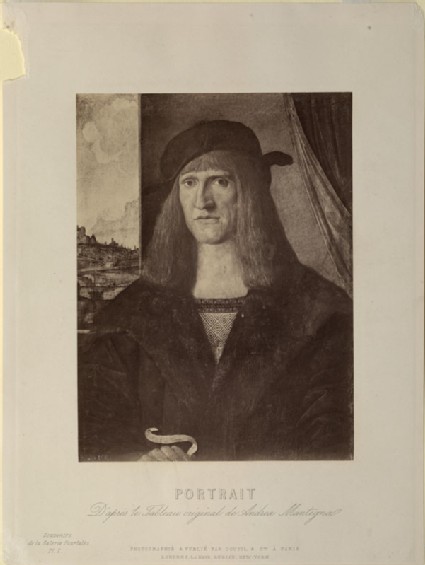Browse: 1470 objects
- Reference URL
Actions
Photograph of a Portrait of a German Man, attributed to Jacopo de' Barbari Goupil et Compagnie
-
Curator’s description:
Description
The painting reproduced in the photograph shows the head, shoulders and upper torso of a man, the space behind him closed off by a wall in the centre and on the right, where a fold of curtain hangs; a window opens up to the left, to reveal an open landscape.
The painting is not by Mantegna, as Ruskin and its owner at the time, the comte de Pourtalès, supposed, but is now attributed to the Venetian painter Jacopo de' Barbari, who worked for the last years of his life in Germany. The painting is now in the Gemäldegalerie in Berlin. The sitter is unidentified, although the Gemäldegalerie's catalogue describes him as a German, and so the painting presumably dates from Jacopo's time in Germany, from c.1500.
The photograph is first recorded in the Teaching Collection in the "Catalogue of Examples" of 1870, when Ruskin listed it in frame no. 36 of the Standard Series, above a photograph of Raphael's portrait of Agnolo Doni; both works retained their positions in the 1872 catalogue of series.
In his catalogue entry, Ruskin compared this painting with the Raphael which, although superficially more attractive, he considered to be inferior. This picture stood as an example of the 'schools of delineation in Italy', and Ruskin praised its craftsmanship in particular, drawing attention to the incredibly detailed depiction of the hair, which reminded him of the famous anecdote in which Giovanni Bellini asked Dürer (then in Venice) to show him the brush he used to paint hair; Bellini was taken aback on being shown a normal brush, apparently expecting to see a particularly fine one on account of the extreme detail of Dürer's handling.
-
Details
- Artist/maker
-
Goupil et Compagnie (photographer)after a work attributed to Jacopo de' Barbari (c. 1460/70 - 1516)
- Object type
- photograph
- Material and technique
- albumen print
- Dimensions
- 169 x 127 mm (print); 259 x 194 mm (original mount)
- Inscription
- On the photograph, bottom left corner, blind-stamped: GOUPIL & C.IE
On the mount, recto, printed:
lower centre: PORTRAIT | D'apres le Tableau original de Andrea Mantegna
bottom centre: PHOTOGRAPHIÉ & PUBLIÉ PAR GOUPIL & C.IE À PARIS | LONDRES, LA HAYE, BERLIN, NEW-YORK
bottom left: Souvenirs | de la Galerie Pourtalès | Pl. 2.
On the mount, verso:
lower right, in graphite: St 36 upper
bottom, left of centre, the Ruskin School's stamp
- Provenance
-
Presented by John Ruskin to the Ruskin Drawing School (University of Oxford), 1875; transferred from the Ruskin Drawing School to the Ashmolean Museum, c.1949.
- No. of items
- 1
- Accession no.
- WA.RS.STD.036.a
-
Subject terms allocated by curators:
Subjects
-
References in which this object is cited include:
References
Ruskin, John, Catalogue of Examples Arranged for Elementary Study in the University Galleries (Oxford: Clarendon Press, 1870), cat. Standard no. 36
Ruskin, John, Catalogue of the Reference Series Including Temporarily the First Section of the Standard Series (London: Smith, Elder, [1872]), cat. Standard no. 36
Ruskin, John, ‘The Ruskin Art Collection at Oxford: Catalogues, Notes and Instructions’, Edward T. Cook and Alexander Wedderburn, eds, The Works of John Ruskin: Library Edition, 39 (London: George Allen, 1903-1912), 21, cat. Standard no. 36
Location
-
- Western Art Print Room
Position in Ruskin’s Collection
Ruskin's Catalogues
-
Ruskin's Catalogue of Examples (1870)
Portrait (I believe the person is unknown) by Mantegna. -
Ruskin's Standard & Reference series (1872)
36. Portrait (I believe the person is unknown) by Mantegna. Portrait by Raphael.The uppermost of these two is far the finest work, though the superficial qualities of Raphael’s are more attractive.
Mantegna’s may be taken as a perfect type of the schools of delineation in Italy; and cannot, in workmanship, be surpassed. Note especially the treatment of the hair, which is drawn with the precision of Dürer, yet the breadth of Titian: and, with respect to the execution of these details by the masters of the fifteenth century, as well as to the method of early practice in drawing with the brush, which I wish you to pursue yourselves, read the following extract from Mrs. Heaton’s Life of Dürer:—
Camerarius relates a pretty little anecdote apropos of the visit of Giovanni Bellini to our artist, which he probably learnt from Dürer’s own lips. He says that Giovanni, on seeing Dürer’s works, was particularly struck with the fineness and beautiful painting of the hair in them, and asked Dürer as a particular mark of friendship, to give him the brush wherewith he executed such marvellously fine work. Dürer offered him a number of brushes of all sorts, and told him to choose which he preferred, or, if he liked, he was welcome to take them all. Giovanni, thinking that Dürer had not understood him, again explained that he only wanted the particular brush with which he was accustomed to paint such long and fine parallel strokes; whereupon Dürer took up one of the ordinary brushes, such as he had offered to Bellini, and proceeded to paint a long and fine tress of woman’s hair, thereby convincing Bellini that it was the painter, and not the brush, that did the work. Bellini avowed afterwards that he would not have believed it possible, had he not seen it with his own eyes. See farther the notes on Edu. 50.





